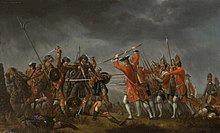The British Grenadiers
It appears in John Playford's 1728 collection of dance tunes as "The New Bath", while Victorian musicologist William Chappell also suggested links to a 1622 work called "Sir Edward Nowell's Delight".
The debate is best summarised by the composer Ernest Walker in 1907 who described the melody as "three centuries' evolution of an Elizabethan tune".
Henry Grattan Flood suggested as another candidate the 1672 Dutch march "Wilhelmus van Nassouwe", which in turn was a reworking of a French version from 1568.
It allegedly commemorates an assault in August 1695 by 700 British grenadiers on the French-held fortress of Namur during the Nine Years War.
[5] Francis Grose in his 1786 work Military Antiquities quoted two lines of the lyrics ("Come let us fill a bumper, and drink a health to those,/Who wear the caps and pouches, and eke the looped clothes") as part of a "grenadier song" he already considered to be "old".
[citation needed] Owing to its popularity, the tune has been frequently set to different texts, including church hymns.
Those heroes of antiquity ne'er saw a cannon ball, Or knew the force of powder to slay their foes withal.

